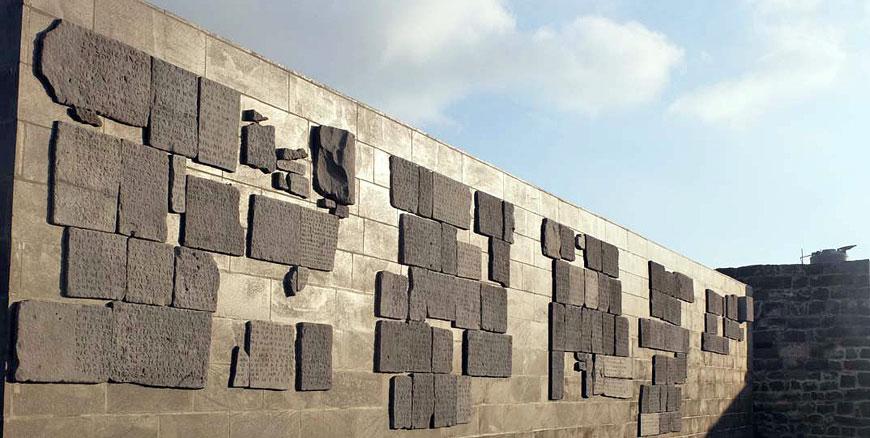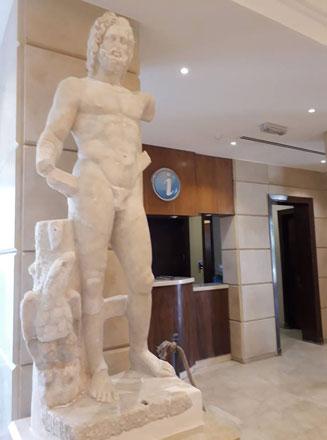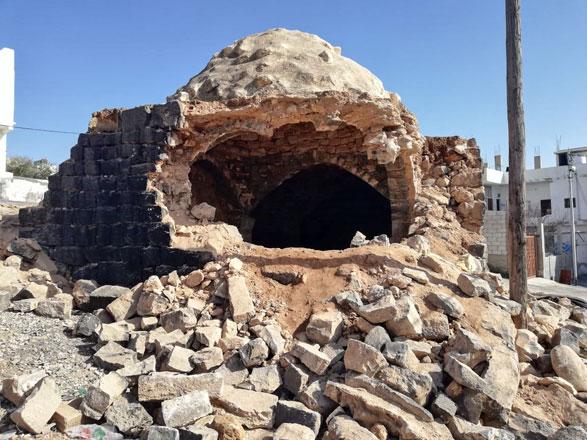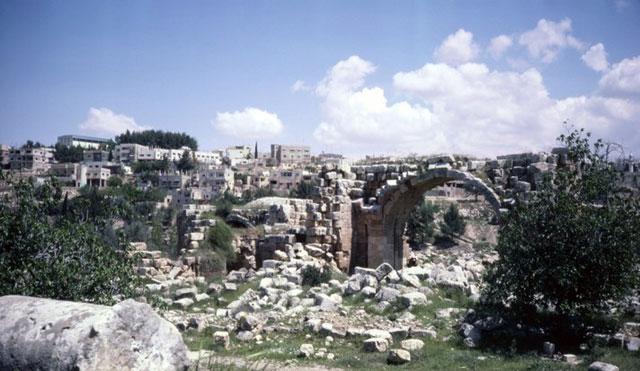You are here
Greek inscriptions at Qasr Al Hallabat third most important monument of Jordan’s literary heritage — scholar
By Saeb Rawashdeh - Mar 06,2017 - Last updated at Mar 06,2017

The Anastasios Edict offers knowledge about the military law issued by Emperor Anastasios I (491-518 AD) which was valid for the Byzantine armies and their Arab allies in the provinces of Arabia, Palestine, Mesopotamia and Clysma (Photo courtesy of Thomas Weber-Karyotakis)
AMMAN — Greek inscriptions containing more than 300 lines and approximately 70 chapters engraved in 160 basalt blocks have been found in secondary re-use at Qasr Al Hallabat, according to a scholar.
The text — found at Qasr Al Hallabat, 35km northeast of Amman — was related to the military administration of the eastern frontier of the Byzantine Empire prior to the rise of Islam.
“After the Qumran Scrolls and the Petra Papyri, the Anastasios Edict is the third [most] important monument of Jordan’s literary heritage,” said Professor Thomas Weber-Karyotakis from the German Jordanian University (GJU).
“Until today, we are able to read and understand the Greek text over approximately 300 lines,” the scholar noted, underlining that the edict “gives us knowledge about the military law issued by Emperor Anastasios I (491-518 AD) which was valid for the Byzantine armies and their Arab allies in the provinces of Arabia, Palestine, Mesopotamia and Clysma [which corresponds with northeastern Egypt]”.
The law regulates the ranks, terms of duty and obligations of the officers and their adjutants, the amount and regulations for the payment of the frontier troops, giving advice for the protection of the Byzantine and Arab soldiers against arbitrary treatment by their superiors, he told The Jordan Times in a recent interview.
Projects in Qasr Al Hallabat and Um Al Jimal, located 70km northeast of Amman, have been a joint effort of local and international institutions and scholars.
“The Department of Antiquities granted full support to the project by issuing an annual permit from 2013 to 2016 to produce silicon moulds and casts from the original inscriptional blocks,” Weber-Karyotakis noted, adding that this activity supplemented the long-term restoration of Qasr Al Hallabat complex led by Ignacio Arce from the Spanish Archaeological Mission to Jordan.
These blocks are mostly in reuse masonry for the early Islamic palaces, but some are scattered today all around Jordan — in Amman, Irbid, Mutah and elsewhere.
Weber-Karyotakis raised the idea three years ago to produce a visual reconstruction of the edict in scale 1:1 at the archaeological sites of Qasr Al Hallabat, Um Al Jimal, the Jordan Museum and the University of Jordan (UJ) campus for the training of Jordanian students in Greek epigraphy.
This physical reproduction of the inscriptional monument over a length of 20 metres aims at creating public awareness and promoting the sites as tourist attractions, he said.
“The three-year project has been financially sponsored by the Foreign Office of the Federal Republic of Germany, the German Research Association and the Gerda Henkel-Foundation,” Weber-Karyotakis emphasised.
Another major discovery that occurred recently is the recovery of the inscription of the Commodus Gate. Roman emperor Commodus ruled between 177 and 192 AD and was the last ruler of the Antonine dynasty (96-192 AD).
“The inscription of the Commodus gate was rediscovered in December 2016 by the students of [UJ] and the GJU at Um Al Jimal. It was reported for the first time in the later 19th century and then by the Princeton University Archaeological Expedition in 1904, but it disappeared afterwards,” he explained.
Scholars thought that the inscription was lost, but fragments of it were rediscovered in December 2016 and were fitted and completed on the basis of old drawings by the students and Jordanian restorers —Khairiyeh Kokhon, Sara Djelani and Musa Samreen—, the expert underlined, adding that “these reconstructed casts can now been seen not only at the ruins of the gate at Um Al Jimal, but [also] in the compounds of both universities”.
The inscription reports the completion of the city wall by a senior Roman officer named Severus, Weber-Karyotakis said.
The period before the rule of Emperor Commodus is considered by many historians as the crisis of the empire, and the construction of the gate was conducted in the period before Commodus began his sole rule, during co-regency with his father, Emperor Marcus Aurelius Antonius (177-180 AD).
However, when Commodus was assassinated in a conspiracy in 192 AD, the Roman senate decided to erase the memory of the unpopular emperor and all portraits and statues of him, and inscriptions mentioning him were destroyed.
The rediscovered gate inscription shows the traces of deliberate erasure.
Regarding further plans at these sites, “the Gerda Henkel foundation will foster the educational work of the Hauran Cultural Centre at Um Al Jimal, which is embedded in the larger USAID SCHEP [Sustainable Cultural Heritage through Engagement of Local Communities Project] directed by Professor Bert de Vries”.
“The cultural centre addresses Jordanian and Syrian children and teenagers to develop a deeper understanding of their mutual cultural roots,” Weber-Karyotakis highlighted.
“They share not only family relations, religion and language, but also a number of mutual traditions concerning [tangible] heritage, customs, dialects and local community history,” the scholar noted.
All this mutual culture has been arbitrarily split by a border drawn by the Western colonial powers after World War I, and since 2011, it has become the most “dramatic line” of refugees entering the Kingdom during the Syrian civil war, he pointed out.
“The Jordan Armed Forces-Arab Army and the people of Um Al Jimal belong to those first Jordanians who provided shelter and safety to their Syrian neighbours and their families after the beginning of this brutal conflict,” Weber-Karyotakis concluded.
Related Articles
JERASH — After years of meticulous work, a French archaeological team that has been excavating the eastern Roman baths in Jerash, unearthed
AMMAN — After recent torrential rains, the Ottoman mosque of Sheikh Khalilat Al Turrah, near Ramtha, was seriously damaged and one of its wa
AMMAN — Peaceful relations between the Arab world and Europe go back to the period of antiquities, according to a German professor. Spe



















